Bug Fables: The Everlasting Sapling Overview
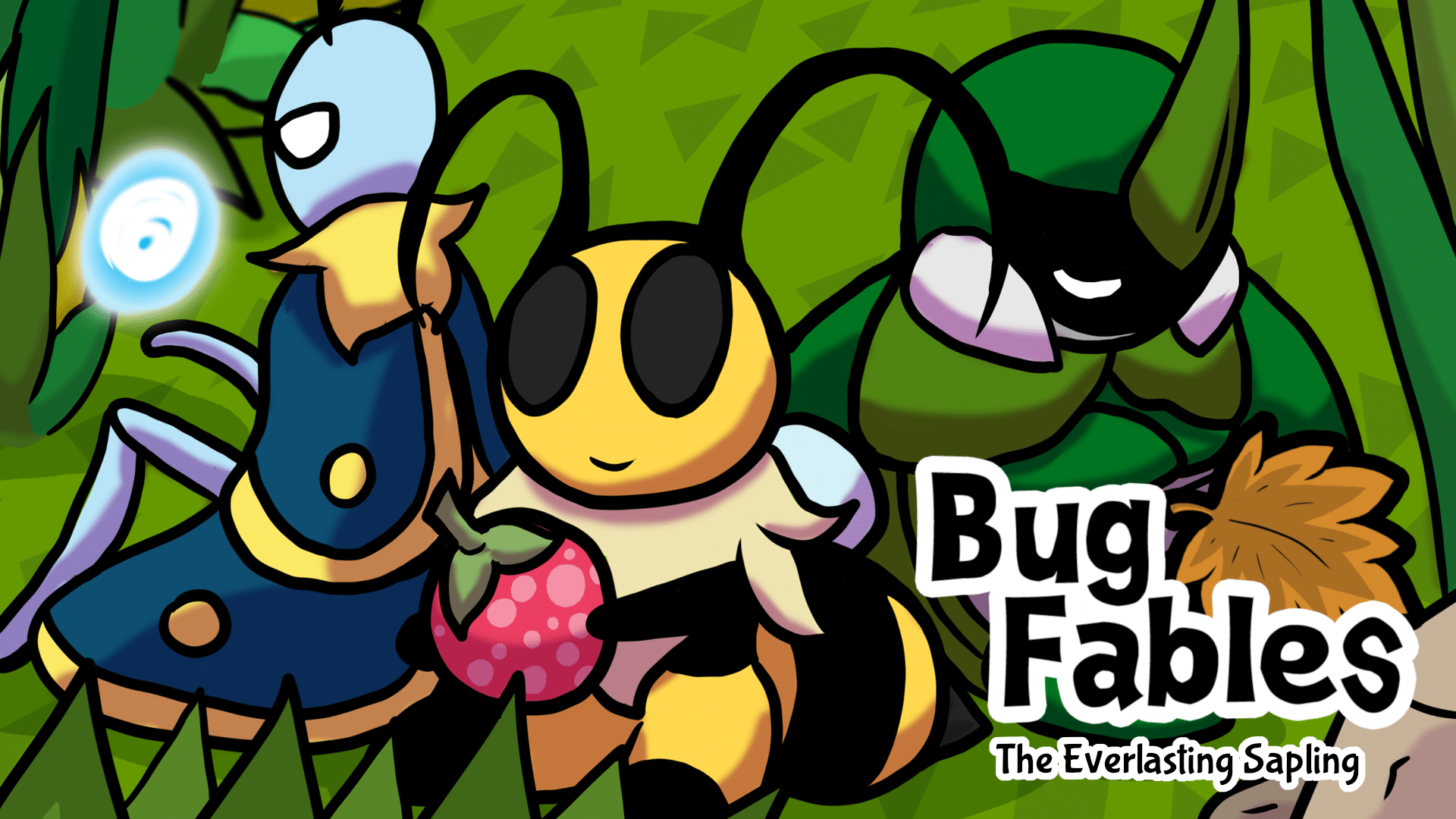 IT'S SO CUTE!!! These are the game's 3 protagonists, as shown in the soundtrack art and the background art on your Steam library.
IT'S SO CUTE!!! These are the game's 3 protagonists, as shown in the soundtrack art and the background art on your Steam library.From left to right: Leif, Vi, Kabbu.
Bug Fables: The Everlasting Sapling, or just Bug Fables, is a lovely, charming game set in the world of Bugaria, inhabited by... you guessed it, bugs. The overall setting is about finding the Everlasting Sapling, which legends tell will bring prosperity to whoever finds it and eats just one of its leaves, and guess what, you'll be going after it. The environments are cute, bright, both simple and detailed at the same time, the characters each have their own unique personalities and storylines, and the music is really catchy and suits the adventurous feel of the game perfectly.
This is an RPG game (role-playing game... game) featuring turn-based gameplay, you assume control of the main 3 protagonists (Vi, Kabbu, Leif), each with their own unique abilities, and it has a number of gameplay mechanics that keep it interesting up until the very end.
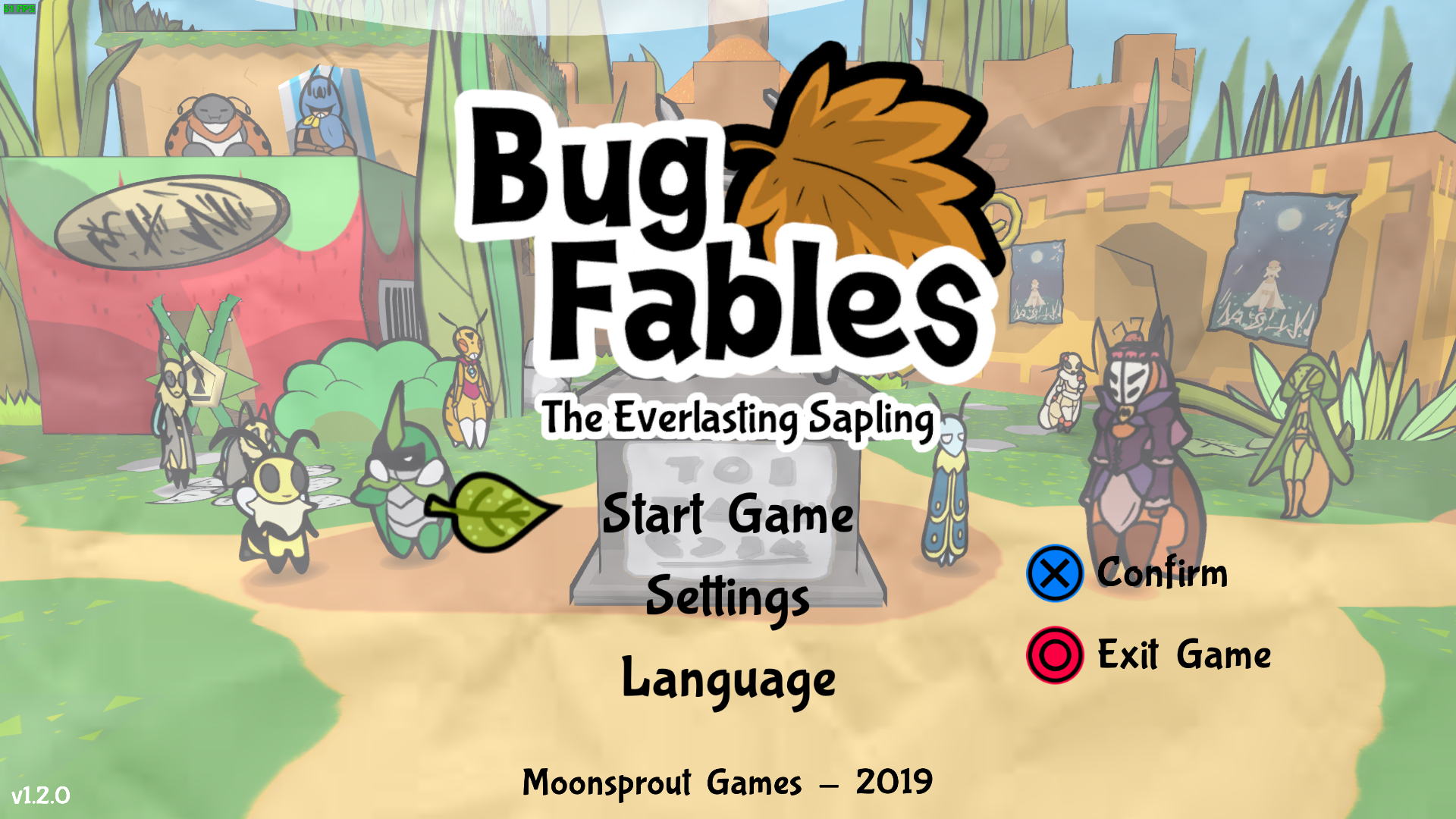 The title screen. It'll change as you make progress in the game.
The title screen. It'll change as you make progress in the game.If you're not familiar with the genre, this game would probably be a good place to start. RPGs have you assuming control of a set of characters, exploring a world, and following the story of whatever's happening in that world, usually something to do with an evil villain character or some other major goal to work for. Generally their gameplay isn't anything to write home about, but what sells them is their story, the overall setting, the music, and just seeing what's gonna happen next and how the characters are gonna develop over the course of the story. Bug Fables is no exception to this.
- Buy Bug Fables: The Everlasting Sapling on Steam
- Buy Bug Fables: The Everlasting Sapling on Itch.io (or download the demo)
Contents:
Overview
⚓In general
⚓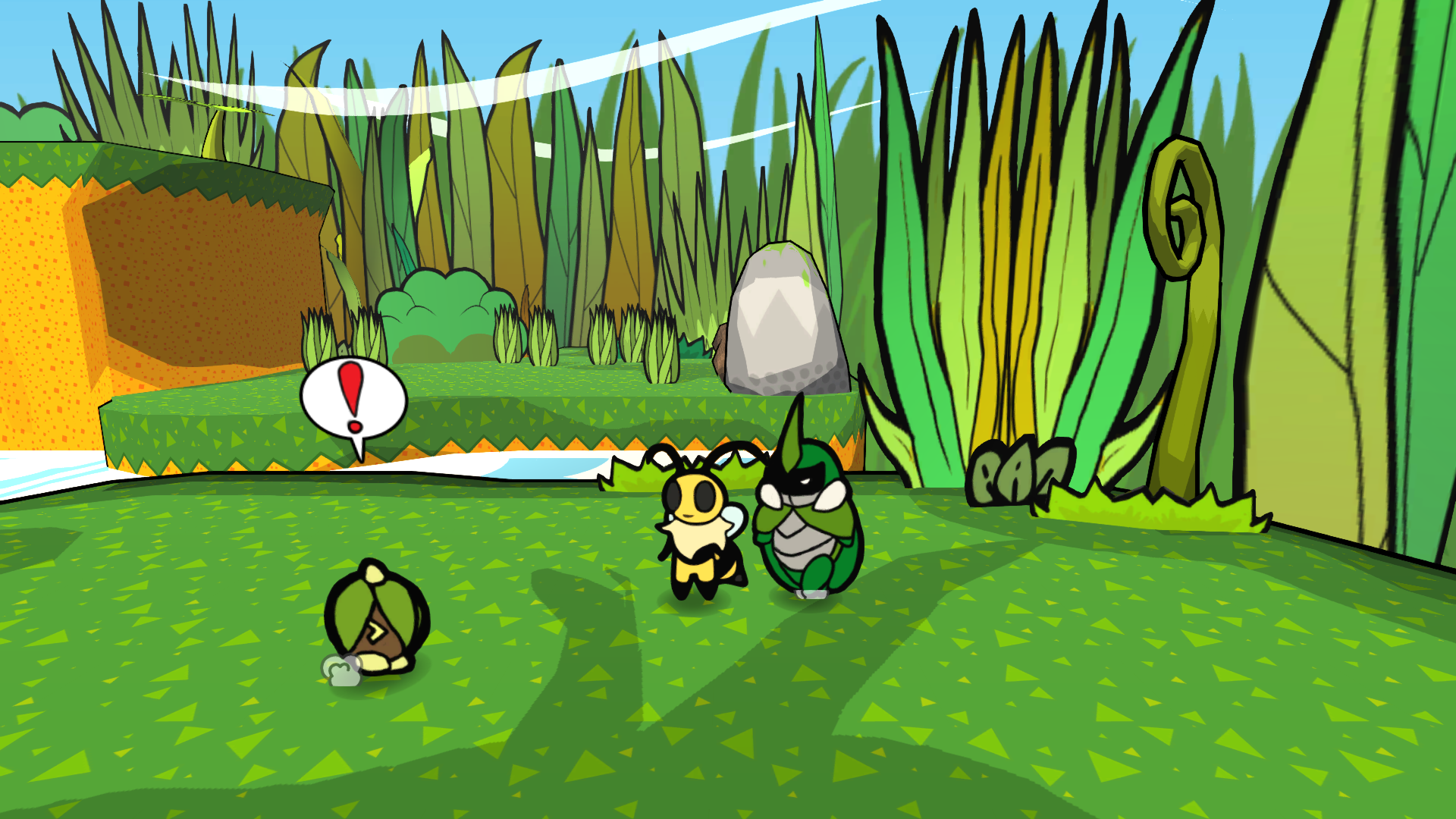 And the adventure begins... this is what the overworld looks like, outside of battle. Touching an enemy initiates a battle. Some platforming and puzzle solving is involved in certain areas.
And the adventure begins... this is what the overworld looks like, outside of battle. Touching an enemy initiates a battle. Some platforming and puzzle solving is involved in certain areas.The overall gameplay is pretty much your typical fare, but with some interesting mechanics to spruce it up. You explore a world, you fight enemies, you advance through the story, you find treasure or can even do side quests, you get more powerful as you defeat more foes. Standard stuff for RPGs.
Inside a battle, you get a fight command, you have skills/magic spells on each character, you can use items, and you have a submenu with commands like spying an enemy (to get additional information about them), passing the turn, or fleeing from the battle. Standard stuff for RPGs.
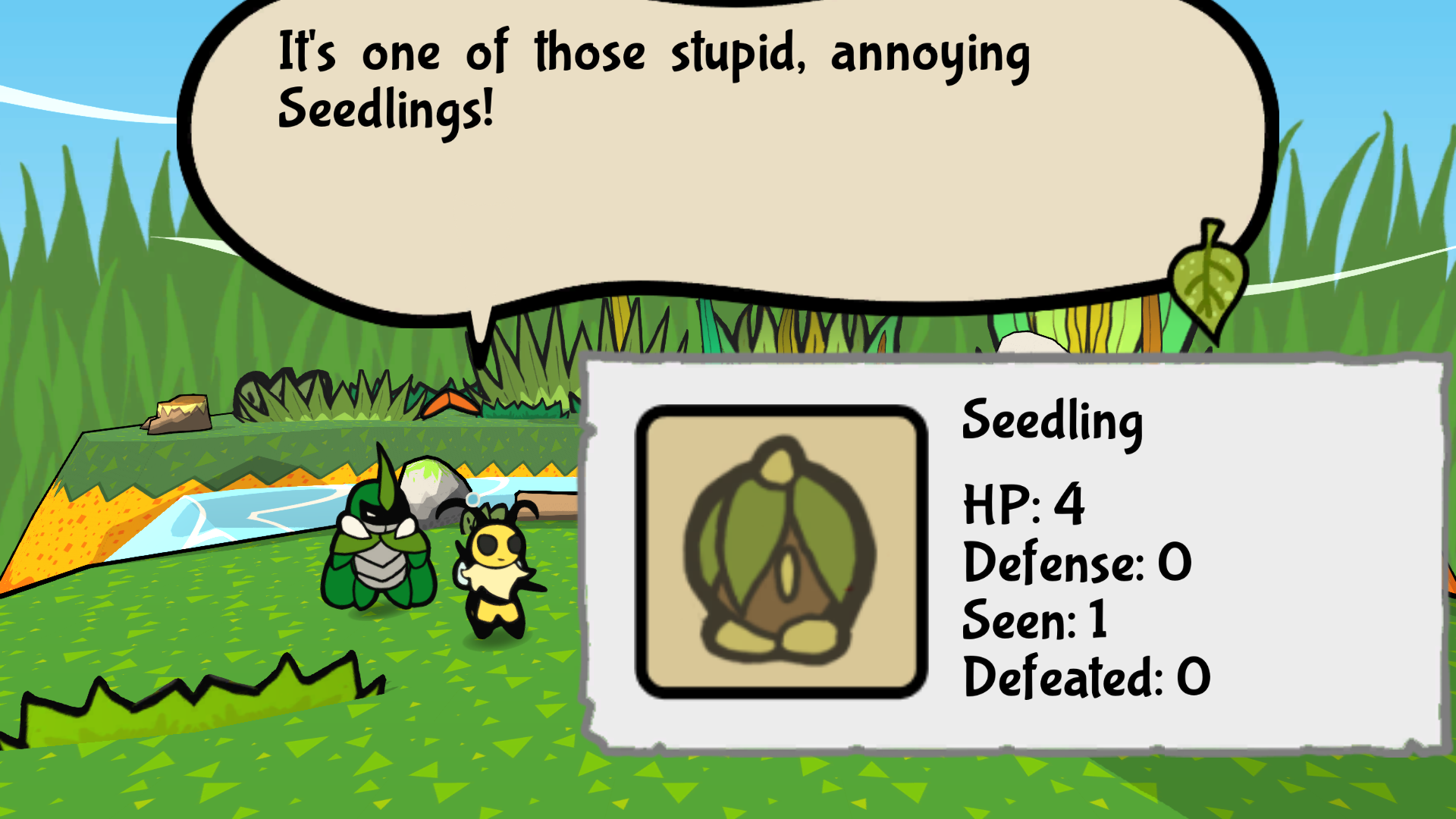 Spying an enemy will bring up its stats, and each character will have something different to say about it.
Spying an enemy will bring up its stats, and each character will have something different to say about it.What makes it stand out is that outside of a battle, each character has a move they can perform to aid with exploration and puzzles. In battle, each has their own strengths and weaknesses, and the battle system is more than just spamming the fight command and let the game autopilot itself, like some early RPGs. The game does a very good job of explaining how to play it, and there's optional ways to make it more challenging if you so wish. I don't know about how accessible it is for people with some disabilities, but it's worth a try. The options menu might be able to help with this, I know that it has an option to disable button mash commands and replace them with a sequence of inputs instead. I personally enable my controller's turbo feature for these (I own an 8BitDo Pro 2, that probably deserves its own article).
You can play this game with a keyboard, or a controller. It supports many types of controllers out of the box, although some might require fiddling with.
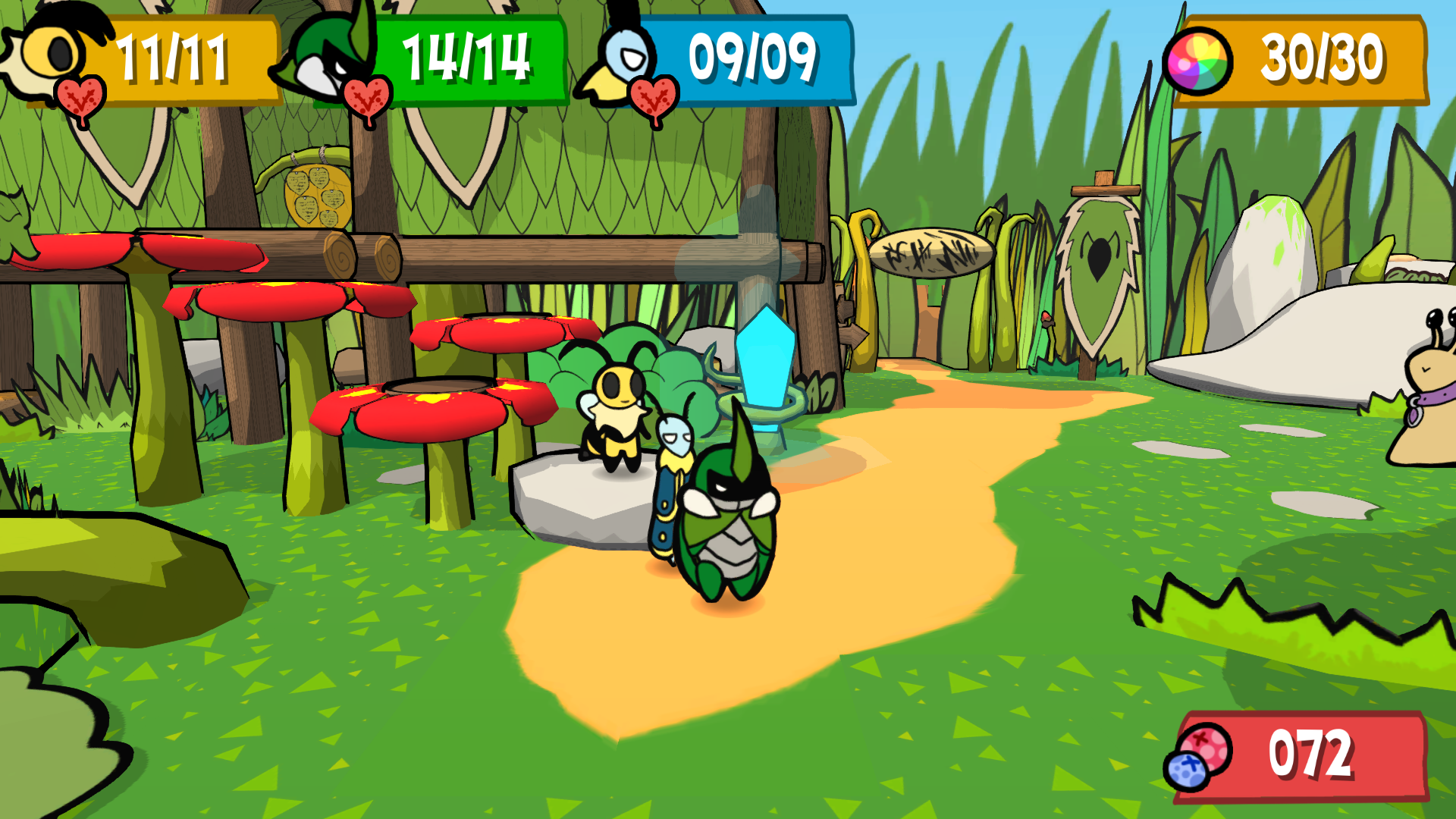 You can whack that blue crystal and it'll show a save dialog. These are plentiful, you're never too far from one.
You can whack that blue crystal and it'll show a save dialog. These are plentiful, you're never too far from one.Lastly, the game is really generous with save and healing points. You can usually feel alright knowing that you're not gonna get screwed by a surprise unbeatable boss, and getting to a previous save point is fast in case you need to leave quickly. Also, after losing a battle, the game will let you either retry, change equipment & retry, or load a previous save point (or quit, loser). Still, save often, and heal whenever you can.
Story and setting
⚓You start the game as Vi and Kabbu, and along the first chapter, you'll have met Leif. The 3 bugs stick together for the rest of the journey. The world of Bugaria feels very charming and it'll probably get your imagination running in many ways. There's a notable lack of generic NPCs with generic dialog, instead making nearly every bug in the world unique, and the way each bug society is portrayed is actually impressively accurate with how they are in real life.
There's points in the story that'll likely make you feel a range of emotions, especially as you get to know each bug, even beyond just your playable characters. When the game ends, the credits appear. It's insane.
People who love trying to talk to everyone and inspect every little item will probably like this game. It doesn't go overboard with it, and usually the things you can interact with are important findings that'll go right into your library of discoveries, where you can read more about them. Others that aren't as important will simply tell you things about the story, or the setting of where you currently are.
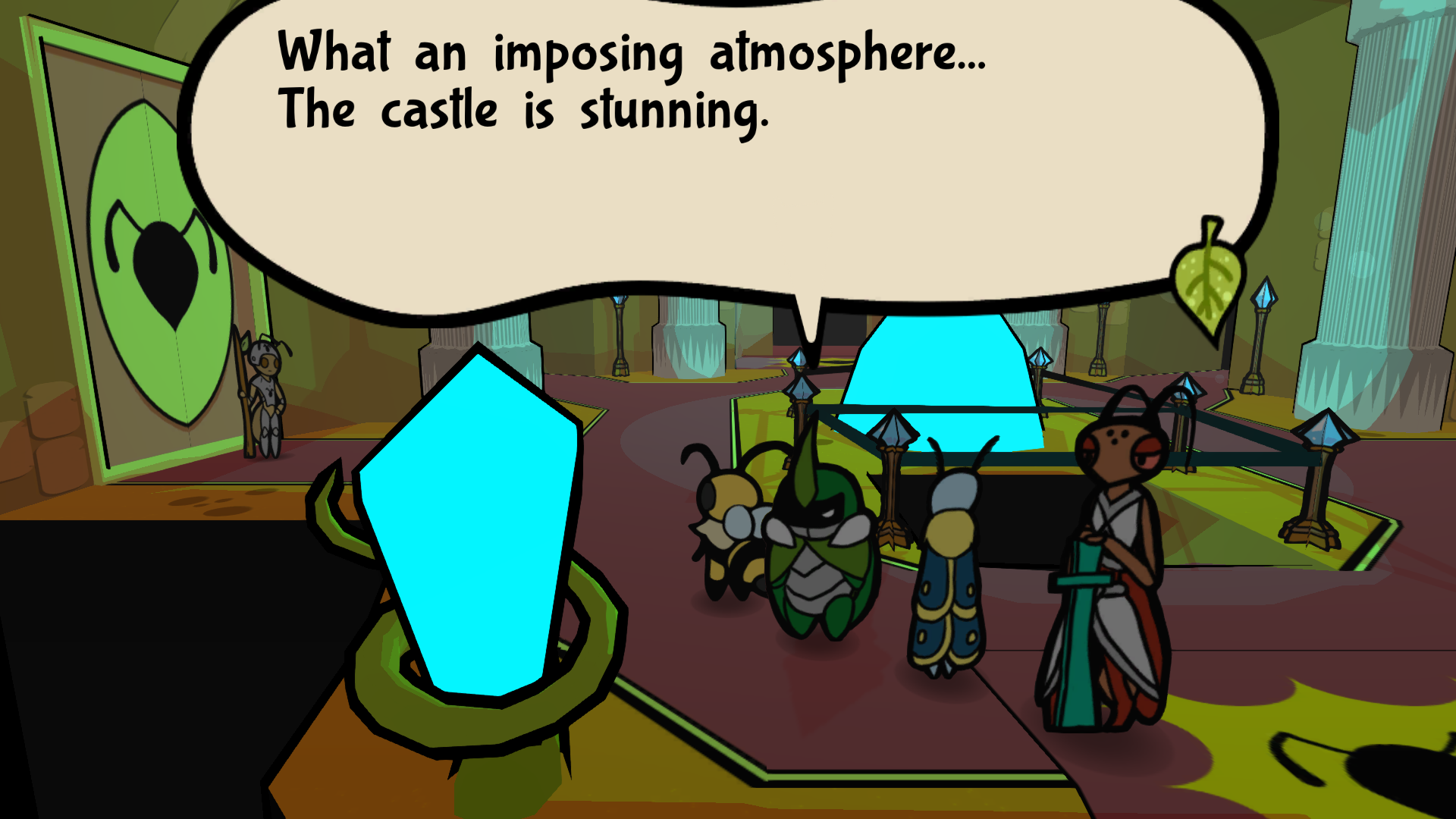 Pressing Select (or whatever's your equivalent) will make your team comment on the current location. This can also serve as a hint system. You can even press it next to other characters, and your team will comment on them.
Pressing Select (or whatever's your equivalent) will make your team comment on the current location. This can also serve as a hint system. You can even press it next to other characters, and your team will comment on them.Music
⚓The art style and the plot itself are greatly accompanied by an amazing original soundtrack with many catchy tunes. What I love about the music is that the melodies are memorable, and the instrumentation is actually really simple. It doesn't ever feel like it's trying too hard, and it doesn't need to. Each song fits well in its place.
My only qualm with the music is that, at least on my end, there's a tiny but noticeable jump when a song loops. I don't think this is present in the released soundtrack, and I don't know if other people experience this. It's a very minor quirk regardless.
The soundtrack starts out relatively playful early on, and progressively gets more serious as you advance through the story. I like that it keeps a great sense of adventure as you reach new areas, with my favorite example being the Far Grasslands, where it really makes you feel like you're straying far away from home and into a vast, dangerous place. It carries an air of mystery, seriousness, and adventure that truly stands out among the other songs in the game.
In general, you can tell that a lot of love and imagination was poured into this game. It almost feels like a child's idea of what a bug society would look like, but conceived as an actual game and with a convincing story, memorable characters, lovely graphics, and catchy music to tie it all together.
Length
⚓The main story doesn't feel disappointingly short, nor ridiculously long. It's just the right length, which means you don't need to no-life this game for a month in order to experience the plot. There's plenty of side quests that you can do, which of course will give you interesting rewards but are otherwise completely optional. I recommend doing them for both the rewards, and to experience some really cool and touching plot points that you otherwise won't see in the main storyline.
I started playing this in 2023, probably gave it a 2 or 3 day run, and put it off after finishing chapter 2. I picked it back up 2 years later and finished it in 5 days of constant playing, with all side quests, for a total of 69 hours, including pauses. I'd say you can reasonably play a chapter in one day or two if you sit down for a couple of hours.
Lost forevers
⚓The game's very well designed in this regard. As far as I know, there's only one item that you can be locked out of obtaining if you don't get it at the right time, but it's something that you can later buy from a merchant anyway, so it's not a huge loss.
There's a character you meet at the beginning, that promises to give you rewards for beating bosses with the hard mode medal equipped. If you don't mind the extra challenge, go ahead, but otherwise you won't be locked out of these if you choose to take the easier route, since you can later buy these rewards from a merchant. Now, there's an achievement tied to defeating bosses with this medal equipped, but you can also do that later on, without having to start a new save file.
You can revisit almost every area you've been to previously, and in fact, you'll need to if you want to do everything there is to do. This is hinted in subtle ways, such as optional paths that you can't quite take yet, or some device that's asking for an item that you can't obtain yet, or treasure hanging just out of reach. The first dungeon gets locked off once you finish it, but it's possible to access it later in the game.
There's even a way to undo your levelup boosts at a later point in the game, in case you ever feel you picked the wrong option. Of course, it comes at a price.
What this all means is that you should play the game at your own pace, and if you see some branching paths, just pick one and see where it takes you. You can always come back later if you missed anything, so don't feel guilty about not exploring everything right away.
Now, if you're like me, you'll want to exhaust every possibility before continuing on. This is okay, but you'll still need to revisit some areas later on, since you won't have the abilities needed for some of the puzzles and treasures yet.
The gameplay
⚓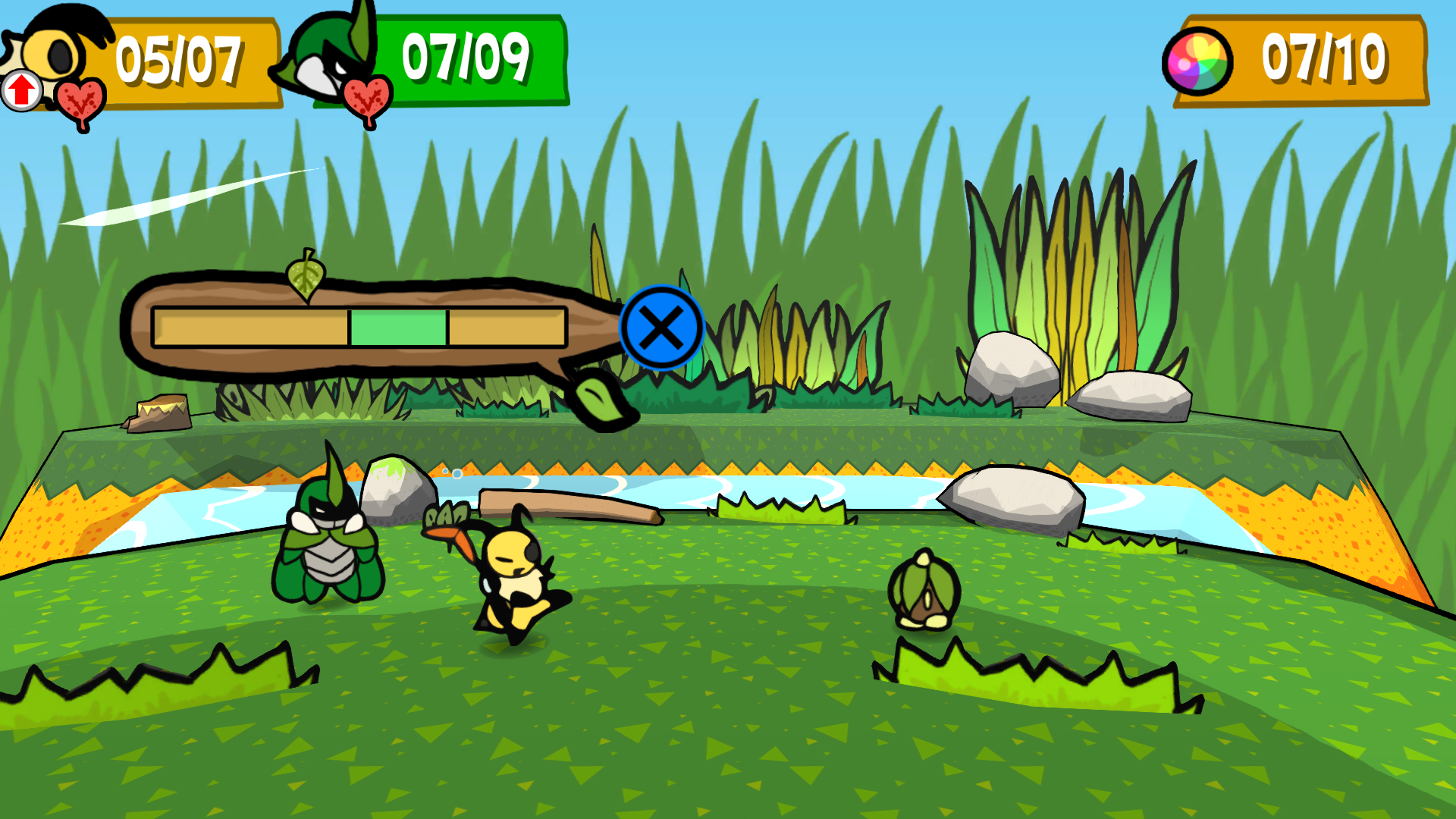 In-game screenshot, showing Vi's fight command in a battle.
In-game screenshot, showing Vi's fight command in a battle.Anyway... this is the part where I start to nerd out, kinda. Everything I said earlier should already convince you to play. If not, or if you just wanna read about the game, go ahead.
In Bug Fables the battle system is based on action commands, where each move has its own sequence of buttons that you gotta press, with the right timing or sequence, in order to make the move succeed. When you're being attacked, you can also attempt to partially block damage by pressing one of the action buttons. If you do it with the right timing, the game will let you know with a sound and some flavor text. There's even a super block that blocks even more damage, rewarded by nailing a really tight timing before you get hit. This particular mechanic adds a bit of a skill element to the game, where you gotta learn enemy attacks and when to hit the block button to effectively reduce how much damage you take. It's reminiscent of Super Mario RPG in this sense.
 A battle in the first dungeon. One of the enemies is flipped after being attacked by Kabbu, which negates its defense.
A battle in the first dungeon. One of the enemies is flipped after being attacked by Kabbu, which negates its defense.Each of your characters has a unique ability with their basic attack that lets you target specific enemies. For example, Vi's boomerang can reach enemies in the air (who are unreachable by the rest of the party), Kabbu can break through enemy defenses with his horn (but he can only attack the first grounded enemy), and Leif can target digging enemies with his ice magic. Some skills/magic moves will let you target enemies that you can't otherwise reach, like Leif's ice magic being able to target airborne enemies, or Kabbu being able to do so by using a move which is granted by an equippable medal.
In addition to this, you can choose in which order your characters will make their move, you can change their location on the battle field to make them more or less likely to get hit, and you can even have one character relay their turn to a different one in the party, effectively letting you move a character twice or more times in the same turn, with a damage penalty that ramps up on further moves. This allows for different strategies when you're up against a tricky set of enemies.
Leveling up
⚓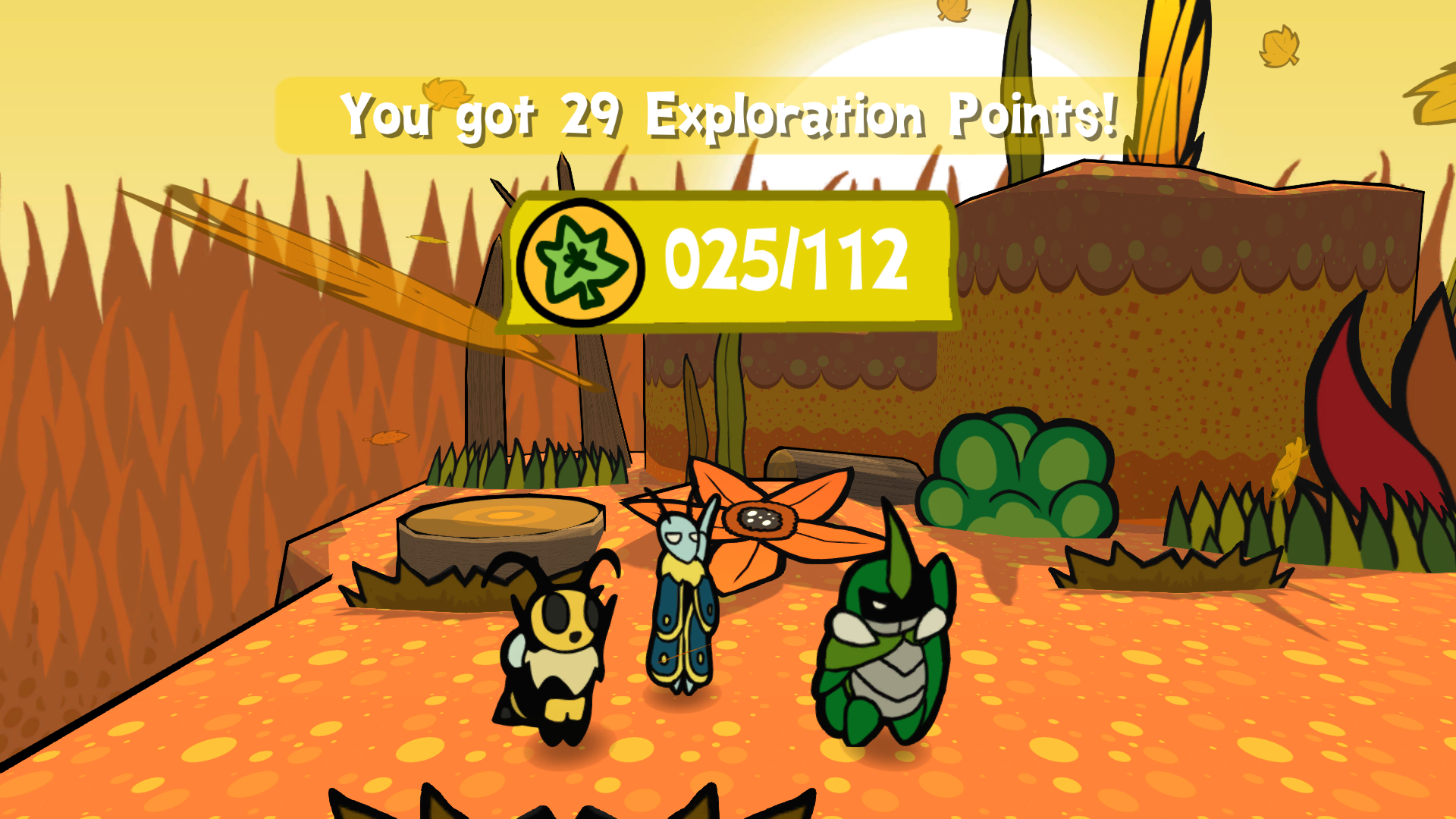 You gain "Exploration Points" after a battle. Leveling up is quick if you're exploring a new area, and really slow if you're trying to grind against weaker enemies.
You gain "Exploration Points" after a battle. Leveling up is quick if you're exploring a new area, and really slow if you're trying to grind against weaker enemies.In RPG games, your character gets more powerful throughout the course of the game, as you fight foes and then mightier foes. This yields experience, or in Bug Fables, Exploration Points (EXP); gathering up enough EXP makes you level up, which boosts your stats and therefore makes you more powerful in battle. There's also usually some kind of equipment system that lets you equip different parts or weapons on your character, in order to gain more attack or defense, or perhaps other things. You also get access to more powerful items as you advance, which can have a variety of effects, including but not limited to: healing in or out of battle, giving yourself temporary stat boosts, or damaging enemies.
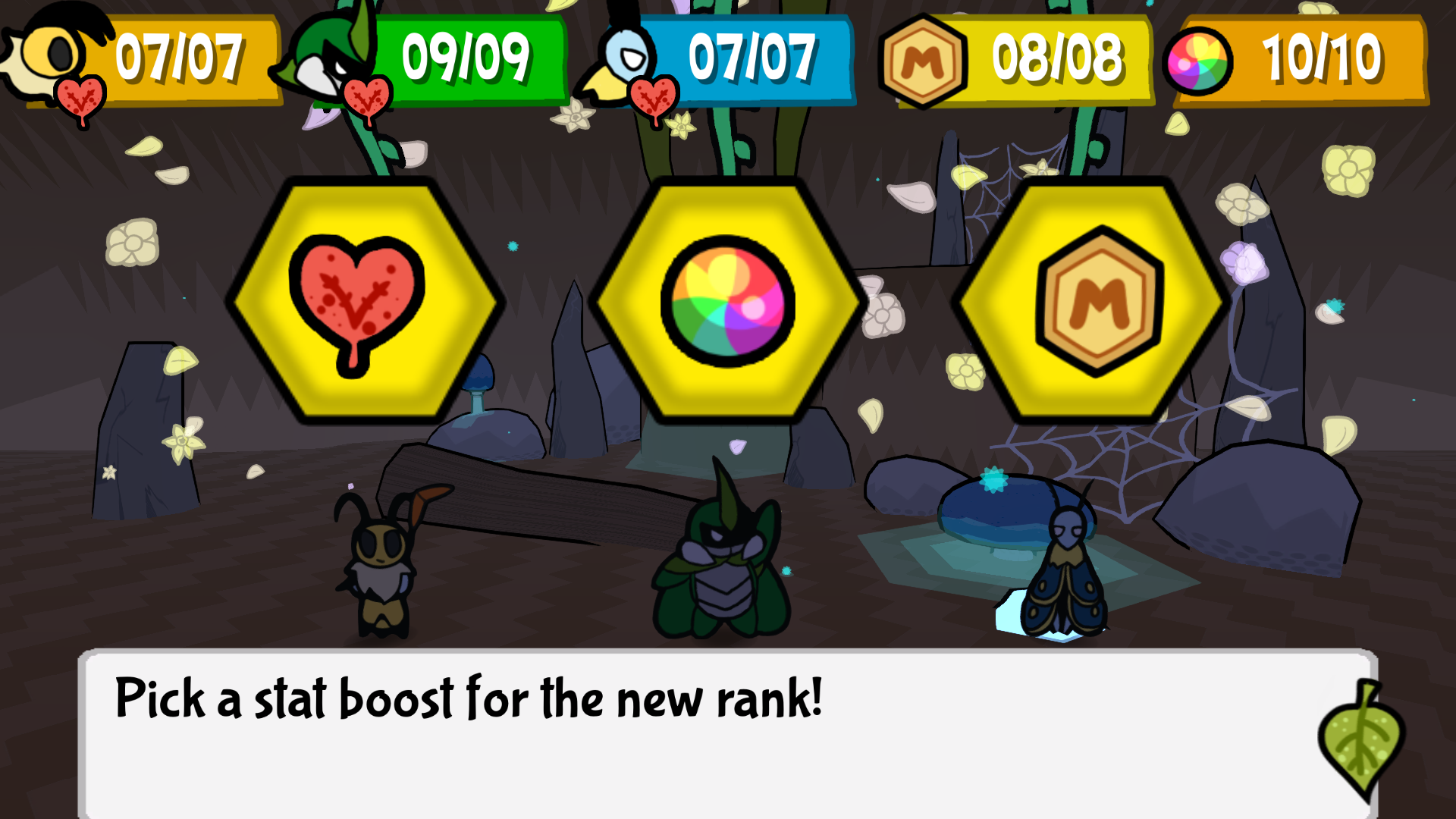 The level up screen, it's so cute.
The level up screen, it's so cute.In Bug Fables, what's interesting is that leveling up doesn't just straight up boost every stat. Instead it gives you a choice about whether you want more health, more points to use magic/skills (known as TP, or Teamwork Points here), or more points to equip medals (aptly named MP, or Medal Points). Your base attack and defense stays the same, so going back to previous areas doesn't exactly let you steamroll through everything, but you'll likely have an easier time either way since you'll probably know the enemies, and you'll likely have more medals equipped and more special moves to use.
Now, here's what I found really interesting. You'll likely notice that after a while, defeating the same enemies will yield less EXP over time, capping at a meager 1 EXP instead of however much they gave you when you fought them earlier. This discourages grinding, which is a good thing if you ask me, and instead encourages you to keep exploring new places and gaining ranks that way. It also prevents you from feeling like you're underleveled for a specific task, since you'll most likely be at the intended rank for that part of the game anyway, unless you grinded for a while or took a lot of side quests. There's specific ranks where you're gonna get stat boosts, but in my experience, they come later in the game. You also have a maximum rank that you can reach, this is hinted by the in-game achievements and is also a good thing, since again it discourages pointless grinding. You can even choose to avoid enemies in the overworld, or equip a medal that automatically defeats weak enemies upon approaching them, without entering a battle.
Equipment system
⚓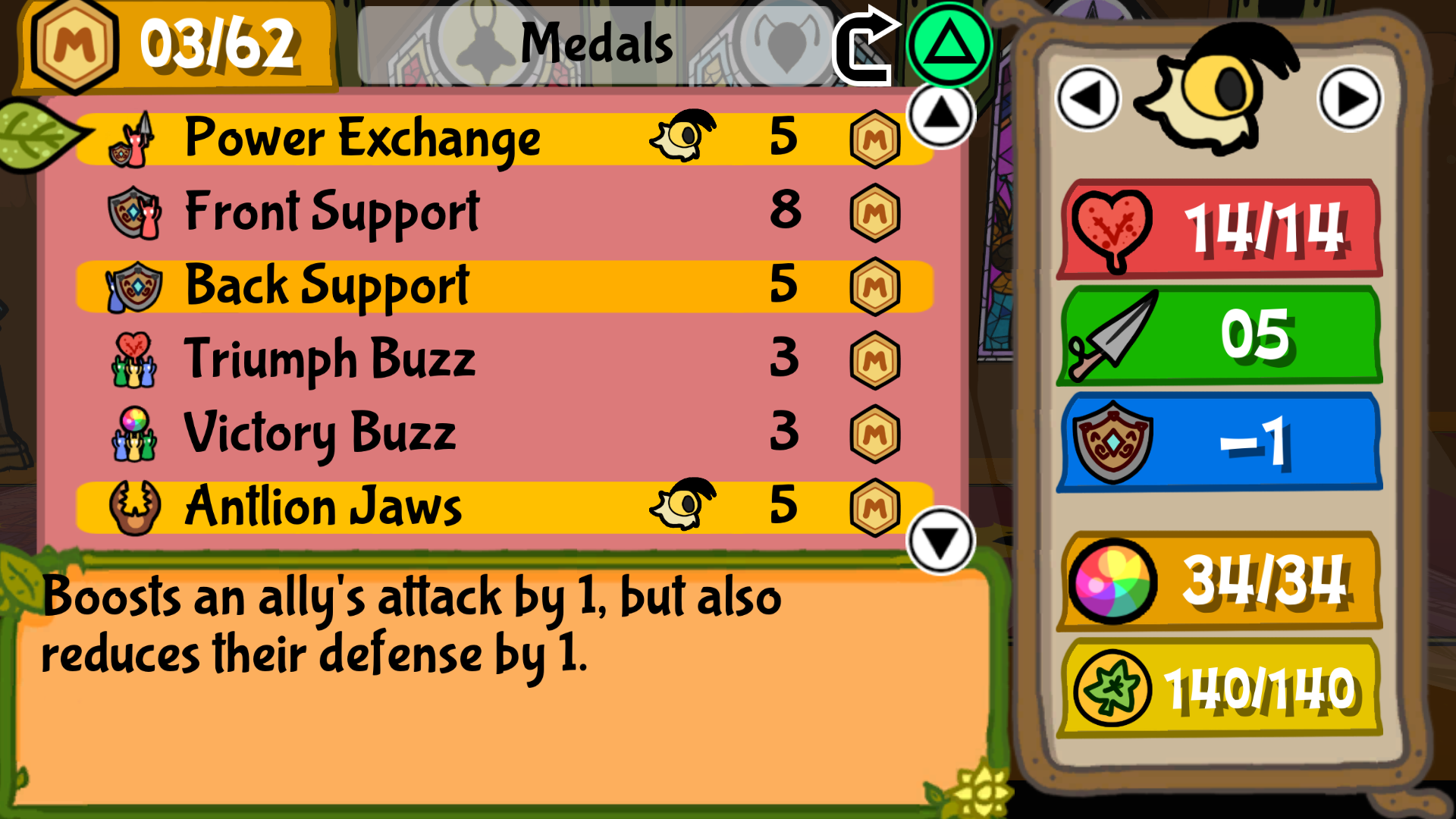 Some of the medals available in the game.
Some of the medals available in the game.The equipment system in Bug Fables is simply equipping medals. You can find them through exploration, buy them, or receive them as rewards for doing certain tasks or quests. The amount of medals you can equip at a time is limited by a stat known as MP, or Medal Points, with each medal having its own cost, ranging from 0 to 8. This stat can be increased upon leveling up, if you choose so. Medals that you obtain will stay available forever, and you can equip and unequip them at your own leisure, while you're not in battle.
Most medals involve some sort of tradeoff, and a few of them are straight upgrades. Some of them affect the whole party, while others are only equipped on one character at a time. I'm not sure how to feel about this, but for example, there's ways to combine the attack boosting medals with the poison medals to become obscenely powerful, at the cost of being weak in battle. A glass cannon if you must.
One thing I don't like is that there's combinations better suited for exploration, and others better suited for boss battles, but there's not a quick way to switch between two sets of medals for the job. It's kinda slow, and the medals feel like they're scattered all over the place in the menu.
The tradeoff thing going on is also kinda iffy, since you can't really get some of the cooler effects without sacrificing something like your defense, or worse, your damage output. There's one medal that heavily boosts your attack but makes you unable to do anything other than attack or pass the turn, and that feels kinda silly when every character relies on more than just their attack command. It's kinda ok for bosses, but for instance, Vi benefits a lot from her Hurricane Toss ability against bosses if she has a high attack, because it hits multiple times and ignores some defense. You can't choose that if you equip that medal. This is kind of a specific case, but overall it can make it feel like you don't have enough options for the harder boss battles.
I do like that you don't have to mess with further layers of equipment though. These days I don't really enjoy having to upgrade weapons, armor, accessories, items, and whatever else they can come up with, especially since upgrades in RPG games tend to be expensive and short-lived. Bug Fables did the right thing here, even if not perfect.
Numbers
⚓Bug Fables opts for small numbers for everything, instead of the ridiculous, sometimes hard to understand high numbers of series like Final Fantasy. Most damage you'll ever deal or take is in the single digits, your defense and enemies' defense is a small number that's never higher than 4, and the calculations are really simple. Say you deal 3 damage, your enemy has 1 defense, then it's 3 - 1 = 2. Enemy health stays in the low numbers as well, with only a few normal enemies having more than 20 health, and bosses also keep their health numbers low, with most staying around the 40-80 range, and only a few ever having more than 100.
The in-game currency, known as Berries, is also a small number. It's kinda like Rupees in The Legend of Zelda, you have a limit of 999 and prices aren't very high for most items. There's a bank in the main town that'll let you deposit any surplus berries that you don't think you need to carry with you, and it has the advantage of your balance gaining interest over time.
The EXP you get is also a small number. The amount of EXP you need to rack up for the next rank does not increase exponentially between ranks, instead doing so in small steps, but as mentioned earlier, killing the same enemies over and over will eventually end up yielding only 1 EXP, so you'll have to explore new areas if you want to gain more. It's possible to keep grinding these small enemies and get a high rank, but it's not worth your time.
It's funny that once you reach a certain point, even the scariest enemies won't yield any experience anymore. Thankfully there's a limit on the maximum rank you can reach (27), and you'll most likely get there or be really close to it by the end of the game, without having to grind.
This section a placeholder
⚓I could keep writing about this game, but I think you should experience it for yourself. It follows the classic RPG formula, with intuitive mechanics, good gameplay balance, simple numbers, and a few features that keep it unique. The environments and story surrounding them are super charming, the characters are cute and memorable, and the music is simple, but very pleasant. If you're not sure, the Itch.io page for the game has a demo available. But really, give it a whirl, it's one of those unique gaming experiences and truly a gem among indie games.
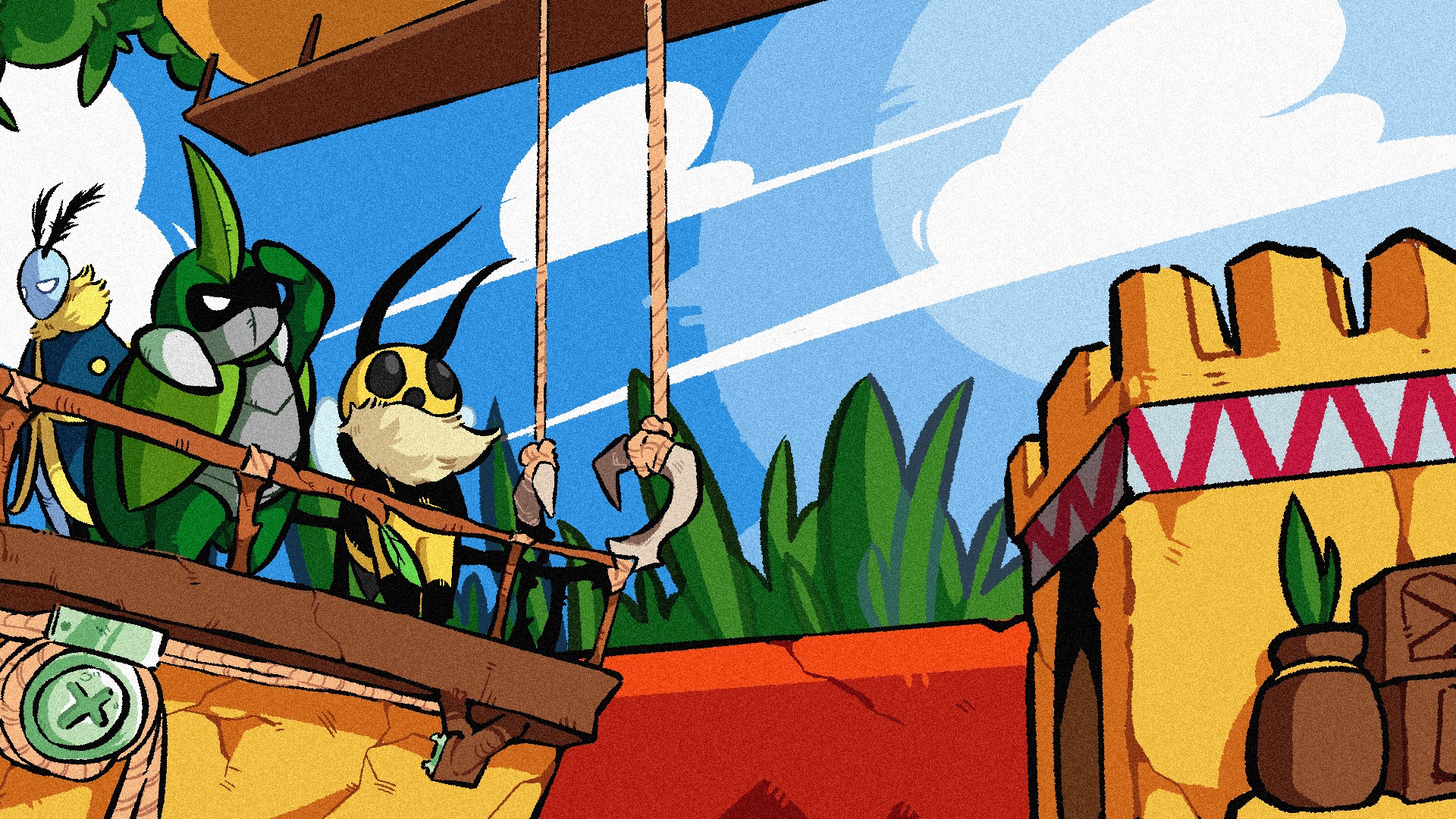 The team on the way to the hive.
The team on the way to the hive.